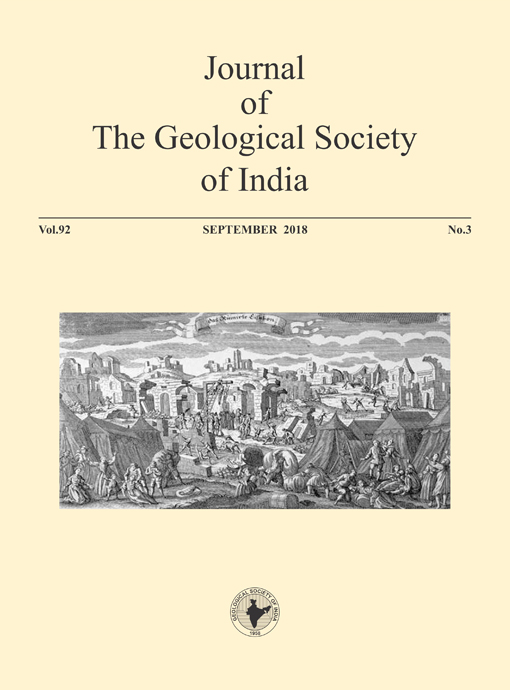Improvement in Engineering Properties of Expansive Soils using Ground Granulated Blast Furnace Slag
DOI:
https://doi.org/10.1007/s12594-018-1019-2Abstract
Improvement in engineering properties of expansive soils by mixing ground granulated blast furnace slag (GGBFS) is the main focus of this research. For this purpose two expansive soil samples were collected from DG Khan and Sialkot areas (Pakistan). Classification tests revealed that DG Khan sample belonged to fat clay (CH) while Sialkot soil was lean clay (CL) as classified by Unified Soil Classification System. GGBFS has been added in varying proportions between 0 and 55% in these soil samples to study its role in stabilizing these expansive soils. Based on the laboratory test performed on composite soil samples, it was observed that maximum dry unit weight increased up to 10 % by adding 50% GGBFS in both samples. California bearing ratio (CBR) value showed an increase from 3.2 % to 11.5% for DG Khan soil while CBR values varied from 2.4% to 10.7% for Sialkot soil by mixing 50% GGBFS. Addition of 30 % GGBFS to DG Khan soil reduced swell potential from 8 % to 2 % while in Sialkot soil, 20 % addition of GGBFS reduced swell potential from 5 % to 2 %. Unconfined compressive strength of remoulded sample cured for 28 days increased by about 35% with the addition of 30%GGBFS. The results indicated that mixing of GGBFS in the expansive soil samples have a marked increase in their engineering properties. Also, it is an affective and environmental friendly means to dispose waste of steel industry.Downloads
Metrics
Issue
Section
Downloads
Published
How to Cite
References
Akinmusuru, J.O. (1991) Potential Beneficial Uses of Steel Slag Wastes for Civil Engineering Purposes, Resources Conservation and Recycling, v.5, pp.73-80.
Al-Rawas, A.A., Taha, R., Nelson, J.D., Al- Shab, T.B., and Al-Siyabi, H. (2002) A Comparative Evaluation of Various Additives Used in the Stabilization of Expansive Soils. Geotechnical Testing Jour., v.25(2), pp.199-209.
Al-Rawas, A.A. (2002) Microfabric and mineralogical studies on the stabilization of an expansive soil using cement by-pass dust and some types of slags, Canadian Geotechnical Jour., v.39, pp.1150-1167, Chen, F.H. (1975) Foundations on expansive soils. Elsevier Scientific Publishing Company, New York.
Cokca, E., Yazici, V., and Ozaydin, V. (2009) Stabilization of expansive clays using Granulated Blast Furnace Slag (GBFS) and GBFS-Cement, Geotechnical and Geological Engineering, v.27, pp.489-499,
Day, R.W. (2006) Foundation Engineering Handbook: Design and Construction with the 2006 International Building Code. McGraw Hill, Singapore p.9.3
Eades J.L., and Grim, R.E. (1960) The reaction of hydrated lime with pure clay minerals in soil stabilization, U.S. Highway Research Board Meeting.
Green, V.G. (2000) Ground and great: Soil stabilization with slag, Building Research and Information, v.28(1), pp.70-72,
Grim, R.E. (1962) Applied clay mineralogy. Mc-Graw Hill Inc., New York Gupta S., and Seehra S.S. (1989) Studies on Lime-Granulated Blast Furnace Slag as an Alternative Binder to Cement, Highways Research Board Bulletin, no.38, pp.81-97.
Higgins, D. (2005) Soil stabilization with ground granulated blast furnace slag, UK CSMA Publication, pp.1-15.
Hughes, P., and Glendinning, S. (2004) Deep dry mix ground improvement of a soft peaty clay using blast furnace slag and red gypsum, Quart. Jour. Engg. Geol. Hydrogeol., v.37(3), pp.205-216,
Indraratna, B. (1996) Utilization of lime, slag and fly ash for improvement of colluvial soils in New Southwales, Australia. Geotech. Geol. Engg. Jour., v.14(3), pp.169-191.
Ingles, O.G., and Metcalf, J.B. (1972) Soil stabilization principles and practice Butterworths, Sydney.
Jiang, L., Chirdchanin, M., and Katsutada, O. (2005) Stabilization effects on surplus soft clay with cement and ground blast furnace slag, Jour. Environ. Sci., v.16(3), pp.397-403,
Kavak A., and Bilgen G. (2016) Reuse of Ground Granulated Blast Furnace Slag (GGBFS) in Lime Stabilized Embankment Materials. IACSIT Internat. Jour. Engg. Tech., v.8(1), pp.11-14, DOI: 10.7763/ IJET.2016.V8.850
Mowafy, Y.M., Bauer, G.E., and Sakeb, F.H. (1985) Treatment of Expansive Soils: A laboratory Study, Transportation Research Record, v.1032, pp.3439 .
Nelson, J.D., and Miller, D.J. (1992) Expansive soils, problems and practice in foundation and pavement engineering, Wiley, New York.
National Highway Authority (NHA), (1998) General Specification, Government of Pakistan 109-2.
Osinubi, K. J. (2006) Influence of compactive efforts on lime-slag treated tropical black clay. Jour. Materials in Civil Engg., v.18(2), pp.175-181.
Pathak, A. K., Pandey, V., Murari, K., and Singh, J. (2014) Soil Stabilization Using Ground Granulated Blast Furnace Slag, Jour. Engg. Res. Appl., v.4(5), pp.164-171.
Rai, A. (2002) Metallurgical slag as a component in blended cement. Construction Building Material, v.16, pp.489–494.
Seggiani, M., and Vitolo, S. (2003) Recovery of silica gel from blast furnace slag, Resource Conservation and Recycling, v.40(1), pp.71–80 .
Sharma, A. K., and Sivapullaiah, P. V. (2012) Improvement of Strength of Expansive Soil with Waste Granulated Blast Furnace Slag. Geocongress, v.6, pp.3920-3928.
Sivrikaya, O., Yavascan, S., and Cecen, E. (2014) Effects of Ground Granulated Blast-Furnace Slag on the Index and Compaction Parameters of Clayey Soils, Acta Geotechnica Slovenica, v.14/1, pp.19-27.
Takhelmayum, G., Savitha, A.L. and Gudi, K. (2013)Experimental Studies on Soil Stabilization using Fine and Coarse GGBS, Internat. Jour. Emerging Tech. Advand. Engg., v.3(1), pp.919-921.
Tsakiridis, P.E., Papadimitriou, G.D., and Koroneos, C.J. (2008) Utilization of steel slag for Portland cement clinker production, Jour. Hazardous Materials, pp.805-811, Available online at www.sciencedirect.com. DOI:10.1016/j.jhazmat.2007.07.093
Wang, L. (2002) Cementitious stabilization of soils in the presence of sulfate Ph.D. thesis, Louisiana State University. Available from http://etd.lsu.edu/ docs/available/etd-0409102-112238/unrestricted/Wang_dis.pdf.
Wild, S. (1998) Effects of partial substitution of lime with ground granulated blast furnace slag (GGBS) on the strength properties of lime-stabilized sulphate-bearing clay soils, Engg. Geol., v.51, pp.37–53.
Wild S., Kinuthia, J.M., Robinson, R.B., and Humphries, I. (1996) Effects of ground granulated blastfurnace slag (ggbs) on the strength and swelling properties of lime-stabilised kaolinite in the presence of sulphates, Clay Minerals, v.31, pp.423-433.
Wilkinson A., Haque, A., and Kodikara J. (2010) Stabilization of clayey soils with industrial by-products. Ground Improvement Jour., v.163, pp.149172.
Yadu, L. and Tripathi, R.K. (2013) Effect of Granulated Blast Furnace Slag in the Engineering Behaviour of Stabilized Soft Soil Proceeding of Chemical, Civil and Mechanical Engineering Track of 3rd Nirma University International Conference, v.51, pp.125-131. DOI:10.1016/ j.proeng.2013.01.019.

 Hassan Mujtaba
Hassan Mujtaba






